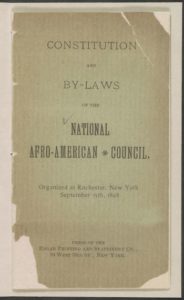
Organization By-Laws (copy)
*On this date in 1898, we celebrate the National Afro-American Council, the first nationwide American Civil Rights organization in the United States.
Founded in Rochester, New York, it dissolved a decade later. The Council provided the first post-Reconstruction national arena for discussing issues for emancipated Blacks. It was also a training ground for some of the nation's most famous civil rights leaders in the 1910s, 1920s, and beyond. Led by A.M.E. Zion Bishop Alexander Walters, president for most of the Council's existence, it attracted a wide range of Black journalists, lawyers, educators, politicians, and community activists to its annual meetings.
The Council was the brainchild of New York journalist Timothy Thomas Fortune, whose earlier attempt at the National Afro-American League had failed to generate momentum and disappeared in the early 1890s. The Council was formed against a backdrop of lynching and increasing disfranchisement of Black voters in the South. Bishop Walters circulated a national appeal letter in the spring of 1898, just weeks after the brutal murder of African American postmaster Frazier B. Baker in Lake City, South Carolina, by an armed mob of whites. “It becomes necessary that we organize to protect ourselves,” Walters wrote, and more than 150 leaders from across the country signed the letter, which was published in Fortune's New York Age.
Some of them attended the organizational meeting in September 1898 in Rochester following the dedication of a statue to the late abolitionist leader Frederick Douglass. The meeting endorsed the creation of a nonpartisan Council to be supported by annual dues payments and based on the ideas expressed by the earlier League. Bishop Walters was elected president after Fortune declined to serve; other officers included journalist Ida B. Wells-Barnett of Chicago, secretary, and federal customs official John C. Dancy of North Carolina, first vice president. The annual meetings began three months later in Washington, D.C., and were held each year thereafter in a large American city, attracting a vibrant cross-section of African American leaders.
Although most of its members were Republicans, the Council also boasted an active minority of black Democrats, in an unusual arrangement facilitated by the group's constitution, which mandated the nonpartisan nature of its proceedings and activities. It was among the first national organizations to welcome women members and treat them equally to men; many national officers were women, and at least one woman from every state served on the national executive committee. The Council lobbied actively for the passage of federal anti-lynching law. It raised funds to finance a court test against the new Louisiana constitution's provision effectively disfranchising most of that state's Black voters under the terms of its so-called “grandfather clause.”
Men judged to be illiterate were deprived of suffrage rights, but white voters with ancestors registered to vote before a specific date were exempted from the literacy requirement. African Americans were unable to qualify for the exemption. The court test, known as Ryanes v. Gleason, was expected to be taken to the U.S. Supreme Court but was eventually dropped after an unfavorable ruling in the Louisiana Supreme Court. The Council was designed as an umbrella group, with membership based on organizational affiliation—either in a local or state branch of the Council or through an affiliated organization, school, or newspaper. Officers were elected annually at the meetings and consisted of a president, nine vice presidents, several secretaries, a treasurer, and a national organizer. In addition, a large national executive committee comprised three members from each U.S. state or territory, including one female member.
The Council was considered the nation's premier organization of African Americans and met regularly with U.S. President William McKinley until he died in 1901. Local newspapers, both mainstream dailies gave its meetings extensive coverage, and African American weeklies in each host city. The Council met in Chicago (1899), Indianapolis (1900), Philadelphia (1901), and Saint Paul, Minnesota (1902). In 1903, the Council convened in Louisville, Kentucky, followed by St. Louis (1904), Detroit (1905), and New York City (1906). Its final meeting was held in 1907 in Baltimore, Maryland.